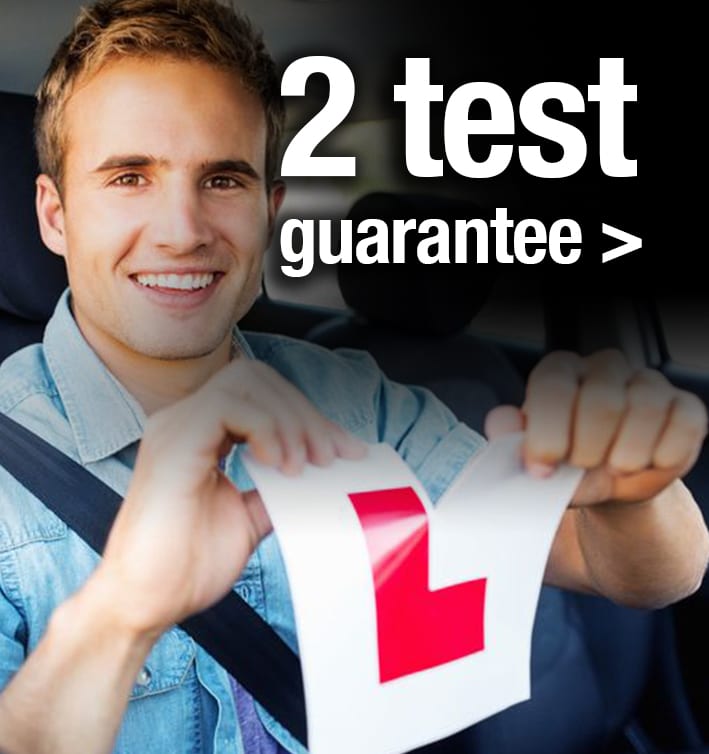In this blog from Tom Ingram (Owner of BIG TOM Driving School) he draws on the experiences pupils recently had with BIG TOM.
The reason why this topic matters is because BIG TOM gets tons of customers who choose to do the popular BIG TOM intensive driving course over the old fashioned “pay as you go” method of learning to drive. Customers like Sarah Crawford who passed her driving test last Thursday at Peterborough Driving Test Centre on her first attempt. Due to where Sarah lives, she met up with me at Peterborough train station for her intensive driving course. She had less than 5 hours of driving experience previously and was graded “red” from our initial assessment of her experience and ability. This means that she would have been explained very clearly the process that we take here at BIG TOM and unlike competitors of ours, pupils with little experience are welcomed but we do not make any false promises of “guarantees” for taking tests on Day 5 of the intensive driving course. Sarah completed her Day 5 on 31/3/17, took a further 3 sessions with BIG TOM and passed her driving test on 27/4/17. Sarah had a need to learn to drive quickly due to her personal circumstances, and she passed her test, first time, in less than a month of taking her course with us.
If that sounds good to you, then it is worth reading on to discover what happened to make that possible.
Sarah was provided with links to exclusive BIG TOM customer driving videos prior to her intensive driving course to help her to prepare for the accelerated learning programme. When she started her course she was provided with further resources that enable her to maximise the learning experience whilst she is both in the car, and then also once she left me each day. She had a Day 3 assessment and then a Day 5 assessment. This enabled her to see precisely what she had done, where she was at with the curriculum and although on Day 5 she hadn’t received a mock test yet, she was given a summary of her ability and confidence levels. On the following 3 sessions she then completed the curriculum of training, and the mock test and was then fast-tracked to receive a driving test.
There are key ingredients in that process that made that work. Not least was the working relationship that was developed between Sarah and myself (this is an important aspect that I expand on in my ebook “Reflections of a Driving Instructor”). Sarah was willing and able to consider her feelings about her driving competence as well as confidence and was happy to also positively engage in the formal assessments that were provided to her. This willingness to identify and deal with the gaps between driving ability and the standard required as set by the DVSA Driving Standard is not insignificant. Whilst it is perfectly possible to coach a pupil to pass a driving test using very lazy techniques, it is not the approach that BIG TOM Driving School adopts. There is plenty of evidence that suggests newly qualified drivers are simply being told how to pass the driving test but not actually being equipped to then drive independently post-test eg accident rates for newly qualified drivers, a national driving test pass rate of less than 50%, expensive car insurance premiums.
And this point is worthy of expanding on. We have a culture within the structure of our educational secondary schooling system of modular learning for exam taking. Essentially, students become conditioned to approach an exam in the knowledge that even if they were to fail, it matters not, as they can then do re-takes at a latter stage. The problem that this presents to them when they are learning to drive is that unlike in the academic world where failing exams affects grades, failing driving tests affects confidence and road safety. The idea that a failed practise mock test can just be re-taken again, with the expectation that the driving standard will have somehow improved is debatable at best. This is fundamentally why at BIG TOM Driving School the emphasis was on getting Sarah’s driving ability to the required standard so that the actual driving test is successfully passed. Entering driving tests with the same approach as entering school exams is one of the top reasons why the national pass rate is as low as it is. There is hope, in that it appears this structure of modular exam taking at secondary schools with re-takes is being phased out to a linear approach.
But in essence the approach that Sarah took was one of being willing to engage in the resources offered to her in her BIG TOM intensive driving course which helped to develop her self-awareness levels of ability and confidence. In addition, she was happy to take on the responsibility of her learning process, so that she was identifying her strengths and weaknesses and ensuring the time spent in the car was really effective.
It is that last paragraph that enables our customers to learn to drive in the timescales they are. There is no cutting of corners of the curriculum, no matter what the starting point of the pupil; all pupils are given experience in driving in differing conditions and class of road as per the DVSA Driving Standard. My driving school is not in existence to enable pupils to take driving tests when they are ill-prepared. If a pupil chooses to ignore the assessments that are provided then they are not taking responsibility for the outcomes. Safety is the number one priority of this driving school. But as mentioned earlier, customers are on an accelerated learning programme where the idea is to continue on the learning path in order to get the desired outcome. Our pupils have a 30 day window in which to become authorised to take the test, Sarah actually passed her test within 27 days. But taking on the responsibility for the learning path is important as the package of benefits are not separately refundable in the event that the 30 day period elapses.
I mention on driving videos and blogs about this necessity to own the learning process. It is massively important. Sarah had a very real need to learn to drive quickly. She listened to our advice about how this can work, and actually acted on the advice. This is a life-skill that unfortunately is being neglected with the modular methodology of our secondary schools. Even some driving schools prioritise the taking and re-taking of driving tests at the expense of the depth of quality training as set out by the DVSA in the Driving Standard.
Another customer did not engage in the methodology of the BIG TOM Intensive Driving Course. She was also an absolute beginner from the start, had 26 hours of in-car training with me, but because she allowed the 30 days to slip by, she lost her right to make use of all the benefits. It was still a fabulous result it should be said – she passed her driving test in her own car, just 6 weeks after completing her 5 day intensive driving course, but she had to fund the driving test fee herself. Despite what many learners would consider to be a fabulous result, she said this on a BIG TOM facebook page:
“BIG TOM taught me alot however he said i was not test ready. I passed in my own car having to pay the driving fee myself due to not taking the test in the instructors car! Im glad i took the test in my own car as i have passed first time!”
What this pupil decided to do was take driving lessons with her Dad in her own car after her intensive driving course rather than with me. This is perfectly legitimate and many customers have asked me in the past to continue training in their own car which makes a lot of sense. But if a customer is wanting to take a driving test in a BIG TOM driving school car it is only sensible on safety grounds, that the instructor be able to assess if the test will be safe for the pupil, examiner and everyone nearby. The performance of professional driving instructors is monitored by the DVSA partly by the quality of the candidates that the instructor presents for test. The DVSA record the outcome of every test to the instructor concerned. Just prior to Sarah’s test last week, we watched an examiner walk back into the test centre which could well have been due to a “test abort”. This can occur when the examiner has so little confidence for the safety of everyone on a test, that they ask the candidate to pull over, and the examiner then walks back to the test centre as they are not insured to drive the car. If this was a test abort that we witnessed, then you can only imagine what would have been said to the driving instructor concerned!
So there is a direct responsibility on driving instructors to ensure only pupils who are safe to do driving tests, are presented for test. But more than that, there is a need for the pupils and their family members to also take responsibility for the safety of all concerned. This is demonstrated beautifully in this graphic. If pupils (and their family members) want to go to test in their own cars, the safety of all concerned is a responsibility for them. But there are no givens in this industry. There are a wide variety of pupils needs when learning to drive. Confidence plays a massive part in the learning path.

But pupils are wrong to assume that it is a given. As we recently put up on one of our BIG TOM Facebook pages:
“Much respect to Christian Whitley-Mason from Barnsley. He has just passed his driving test on the 33rd attempt! 14 different driving instructors and £10k in cost. I take my hat off to the chap.”
But this subject of responsibilities for maintaining safety is important at the other end of a drivers life too. Family doctors were historically encouraged to persuade their patient to stop driving and were only supposed to contact the DVLA if they failed to do so. Recent changes mean now that the GP is not duty bound to discuss the matter with the patient on all occasions. The General Medical Council is advising GP’s to inform the authority when it isn’t “safe or practicable” to try to persuade the patient such as when the patient poses an imminent risk to themselves or others.*
Road safety is after all one of the key reasons of maintaining standards of driving on the roads. It can sometimes be a difficult concept to get over to learner drivers when they might be exposed to some rather poor driving by others while they train. But in the UK all of us do only get one compulsory assessment of driving standards. It really does pay to train well, comprehensively and aim high with driving standards. The consequences of not doing so includes driving around not feeling confident, having accidents, picking up penalty points, court appearances, paying high insurance premiums, frightening people in the vicinity, being banned from driving.
The best piece of advice that I could give any person who is looking to learn to drive soon is to put aside the goal of wanting to pass the driving test soon. Everyone but everyone wants to pass the test as soon as possible. Much more important is to try to appreciate what kind of learner you are. If you do not have any inclination to embrace the concept of taking responsibility for your learning path and the standard of driving needed to maintain safety on the roads, then it may well prove best to take the option of learning to drive the old fashioned route of every now and again. But although my driving school can provide customers who have a need to pass fast the opportunity to do just that, like Sarah last week, it is important to recognise that it will not be for everyone. I cannot speak for how other intensive course providers run their courses, but a BIG TOM Intensive Driving Course is not for pupils who want to cut corners and fast track to get a driving licence at the expense of road safety.
*Source: The Week 29/04/17
BIG TOM Driving School Enquiries: Admin@BIGTOM.org.uk Sales: 07756 071 464




